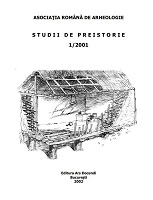Studiu sedimentologic preliminar asupra locuirii neo-eneolitice din valea Teleormanului, zona Lăceni – Vităneşti. Southern Romanian Archaeological Project, campania 2000
Preliminary sedimentological study of the neo-eneolithic habitation from Teleorman valley, Lăceni – Vităneşti area.
Author(s): Constantin HaităSubject(s): Archaeology, Physical Geopgraphy
Published by: Editura Cetatea de Scaun
Keywords: neolithic; tells; sedimentology; alluvial deposits;
Summary/Abstract: This paper presents the preliminary results of the sedimentological study during 2000 field season within the framework of Southern Romanian Archaeological Project, centered upon the study of the neolithic occupation in floodplain zone of Teleorman River Valley, attributed to Boian culture, and the study of the formation and evolution of the tell-type settlements by sedimentological analyse of the stratigraphic sondages realised in two eneolithic sites. For 2000 field campaign, the main goals of the sedimentological study in the Teleorman River was the description and interpretation of the sedimentary sequences and to establish the stratigraphic relations between the occupation layers and the alluvial units accumulated during the flood events. As it concerns the study of the tell type settlements, the soil coring survey on the slopes of Vităneşti tell, on four transects oriented N, S, E and W, evidentiated the fact that the layers including cultural material are situated at different altimetric levels and are separated in one situation by loose beige silts without traces of anthropogenic activity. As the consequence of this study, was proposed to excavate a sondage to enable the registration of the secure context of the cultural material and the stratigraphic relationship between the cultural layers and the natural substrate. This work was performed in tells as Borduşani-Popină and Bucşani-Pod and such sondages emphasised situations where cultural levels attributed to Boian and Gumelniţa cultures are separated by alluvial deposits, this fact setting up the problem of the formation and evolution of the tells. In the Boian settlement TEL. 008, the corelation of the sequences observed in the studied sondages, reveals successive phases of neolithic occupation, that are separated by natural accumulations. The topographic differences between the Boian occupation levels suggests, as it was considered as result of the study during the 1998 field stage, a paleotopography consisting in higher areas, where carbonatic and clay rich soils are formed, and lower areas, near to the floodplain between the alluvial channels. The successives levels of Boian occupation observed in TEL. 008 are separated by levels with carbonatic silts accumulated during floods and pedogenetically transformed during the occupation phases. The micromorphological study of a soil horizon of this type emphasized the fact that some important features of calcium carbonate accumulation correspond to human related activities. During the period corresponding to the Boian culture and to the phasis A1 of Gumelniţa culture, in this area of the floodplain of Teleorman, the migration of the alluvial channels determined the reworking of the anthropogenic constituents from older areas of occupation. As can be observed from the description of the stratigraphic sequences studied in the tell-type settlements Lăceni and Vităneşti-Măgurice, the neo-eneolithic occupation is represented by four respectively three occupation levels, separated at certain cronological levels by important accumulations of natural origine. From this point of view, the formation of the tell type settlements represents the answer to the environment compulsions, caracterised in this period by an important rising of the hidrostatic level, the destruction of some occupation zones and the reworking of the anthropogenic constituents included in natural deposits. In both tell type studied settlements, first occupation level is indicated by cultural material reworked and accumulated in salty or clay deposits. After an important natural accumulation, within can be separated many phases, can be observed first in situ Gumelniţa occupation level. This corresponds to the phase A1 at Viăneşti and to the phase A2 at Lăceni. In the first one, the dwelling attributed to Gumelniţa A1 is situated in the lower part of the step formed by the natural accumulation, that can be the case of an alluvial bar situated in the proximity of a swamp area. This occupation level is covered by another accumulation of natural origin. After this, the occupation attributed to Gumelni]a A2 and B1 is situated in the upper part of the tell. In the case of tell Lăceni, first level of in situ occupation corresponds to Gumelniţa A2 and is followed, in the upper part of the tell by the Gumelniţa B1 occupation level. As it concerns the formation and the evolution of the tell-type settlements, the stratigraphic sequences studied in the two sites emphasized the fact that the periods of occupation are interrupted by periods of natural accumulation, that suggest, in the absence of any evidence of human activity, periods of abandon. We have to mention here that from the geomorphological point of view, the studied occupation attributed to Gumelniţa A1 phase resemble better with the Boian occupation, with the difference that the first one is situated closer to the terrace. This fact means that the two tells investigated represent stable settlements, from the point of view of the relations with the natural landscape, only for the period Gumelniţa A2-B1. We wish to adress our warmfully thanks to
Journal: Studii de Preistorie
- Issue Year: 2001
- Issue No: 1
- Page Range: 47-58
- Page Count: 12
- Language: Romanian

